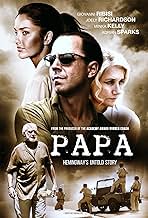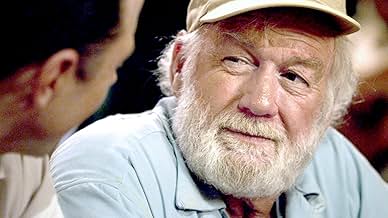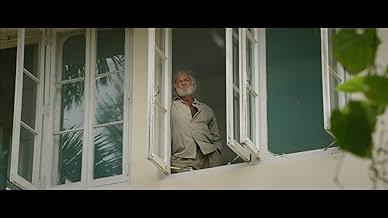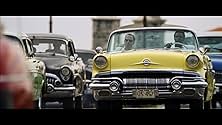IMDb रेटिंग
6.3/10
1.8 हज़ार
आपकी रेटिंग
अपनी भाषा में प्लॉट जोड़ेंIn 1959, a young journalist ventures to Havana, Cuba to meet his idol, the legendary Ernest Hemingway who helped him find his literary voice, while the Cuban Revolution comes to a boil aroun... सभी पढ़ेंIn 1959, a young journalist ventures to Havana, Cuba to meet his idol, the legendary Ernest Hemingway who helped him find his literary voice, while the Cuban Revolution comes to a boil around them.In 1959, a young journalist ventures to Havana, Cuba to meet his idol, the legendary Ernest Hemingway who helped him find his literary voice, while the Cuban Revolution comes to a boil around them.
- पुरस्कार
- कुल 2 जीत
Joseph Peréz Bertót
- Roberto Herrara
- (as Joseph Bertót)
फ़ीचर्ड समीक्षाएं
Well, okay, maybe the one about continuity -- I had a hard time following the time line of how long Ribisi's character was in Cuba each time ("returning on Tuesday" seemed awfully short compared to everything that happened while he was in Cuba), but I'll overlook that in favor of the story and the excellent acting by the cast. I feel that Adrian Sparks portrayed Papa in all of his flawed, tortured glory without going over the top. The audience senses the churning volcano beneath the surface that occasionally bursts forth. After reading "Hemingway in Love" this past winter, I had a greater depth of understanding for the unresolved guilt and regret that Papa carried in his later years. Joely Richardson was perfect as Mary, a woman who actually had a very interesting life all on her own but who was perpetually in the shadow of the great man. Giovanni Ribisi played his role quite well -- any woodenness belonged to the character and his repressed feelings of abandonment, not to the actor's characterization. Loved the movie, and now must read the book!
Papa is lovingly photographed in Cuba where the story takes place in 1959, with an aging and depressed Ernest Hemingway, a Cuban revolution, and a young reporter who develops a relationship with Hemingway. Adrian Sparks captures Ernest Hemingway to such an extent that we believe we are watching home movies of the real Hemingway. It's helped by being filmed in Hemingway's Cuban home, which is now a national museum. Joely Richardson is similarly marvelous in the role of Hemingway's wife.
The film has a quiet lyrical tone even while there are turbulent under currents involving Batista, J. Edgar Hoover, the Mafia, and Fidel Castro's rebels. But the heart of the story is the relationship between the reporter (Giovanni Ribisi) and the Hemingways, as the orphaned reporter becomes part of their "family" and learns for himself what being part of a family truly means.
The film will have limited appeal and is best viewed by people interested in Hemingway, or the Cuban revolution, or intense family dramas. AS an added bonus, there are lots of 1950s cars on display, which is a real treat for the eyes.
The film has a quiet lyrical tone even while there are turbulent under currents involving Batista, J. Edgar Hoover, the Mafia, and Fidel Castro's rebels. But the heart of the story is the relationship between the reporter (Giovanni Ribisi) and the Hemingways, as the orphaned reporter becomes part of their "family" and learns for himself what being part of a family truly means.
The film will have limited appeal and is best viewed by people interested in Hemingway, or the Cuban revolution, or intense family dramas. AS an added bonus, there are lots of 1950s cars on display, which is a real treat for the eyes.
In literature, there is a term called the "Hemingway Hero," which is essentially a set of noble traits and honorable qualities that the reader should aspire to, much like any character in an Ernest Hemingway novel. Every writer attempting to create this attribute will find that the qualities that make up a hero today compared to that of Hemingway's day are consistent and timeless. This idea of what makes a man a man, and living a life of "honor, courage and endurance in a world that is sometimes chaotic, often stressful, and always painful" will forever ring true to those in search of a deeper meaning of life. The Bob Yari-directed film Papa: Hemingway in Cuba, tells the true story of one man's relationship with the legendary writer Ernest Hemingway, and essentially starting his journey to find his own, literal, "Hemingway Hero".
"What do you say to the man who changed your life, and never even knew you?" Ed Myers (Giovanni Ribisi), a journalist at the Miami Herald in the 1950s, asks this question while struggling to find the words for a letter he plans to send to his idol, Ernest Hemingway (Adrian Sparks). Growing up an orphan during the depression, Myers' voice-over explanation reveals that he had always wanted to be a writer and an adventurer. His lack of family ties created a longing for someone to look up to, someone to be a father figure. He writes all of this and more in his letter, spilling his soul onto the page. Then, one day, Myers gets a life-changing phone call from the man himself, telling him how much he appreciated the letter and then asking him to travel to Cuba to spend time with him.
While the first third of the film tends to drag a bit slowly, it really comes alive when we follow Myers to Cuba and get to meet Hemingway. The atmosphere of the city and live music are electrifying, a juxtaposition to the man Hemingway had become by that point in his life. Myers quickly develops a closeness to Hemingway and his wife Mary (Joely Richardson), considering them the family he never had. However, their blissful life erupts into chaos as they immediately find themselves in the middle of the Cuban revolution.
The fact that this is a true story alone is worth watching, but probably the biggest selling point is that this is the first Hollywood film to be shot in Cuba in over 50 years. The authenticity of being able to shoot in the original locations including the bar El Floridito and Hemingway's actually home in Finca Vigia, which is now preserved as a national museum, is a fascinating thing to see. Possibly the coolest memento of all, though, is that the typewriter used in the film is Hemingway's original one.
Personally, a big fan of Hemingway myself, (I did name my dog Ernest after all), seeing this time period in his life is difficult as we all know the outcome of his losing battle with depression. It is a hard pill to swallow watching him stick a revolver in his mouth and beat his wife. For as beautiful the worlds he created in his books, the man we see on screen is a tortured artist that is struggling to see the purpose of his own life. Adrian Sparks captures both Hemingway's brilliance and demons in his performance, truly giving justice and respect to the late author.
As much as you become absorbed in Sparks' performance, there are moments that can take you out of the film. At times Ribisi comes off somewhat flat, for example, getting that initial call from his idol, Hemingway himself, he barely seems to muster up any excitement. Instead, it feels as if that scene may have been rehearsed one too many times and, by that take, he was just going through the motions. Another head scratching moment is how quickly the film jumps into some scenes without much setup. One moment, Myers is on the beach in Cuba, the next he's on the beach in Florida telling his girlfriend (Minka Kelly) about his trip to Cuba. It feels rushed, but at this point, we've become invested in these characters that we're along for the ride so we don't really care where we're going or how we get there.
Papa: Hemingway in Cuba is a stunning portrait of one of the greatest authors and storytellers of the 20th century. Bob Yari takes the biopic and breathes life into the genre just by the sheer amount of authentic details (like the shooting locations alone), plus this inspiring and true story of one man's search for the meaning of life is something we can all relate to. Bonus- Keep an eye out for a quick cameo from Ernest's granddaughter Mariel Hemingway.
For more, visit www.cinemacy.com
"What do you say to the man who changed your life, and never even knew you?" Ed Myers (Giovanni Ribisi), a journalist at the Miami Herald in the 1950s, asks this question while struggling to find the words for a letter he plans to send to his idol, Ernest Hemingway (Adrian Sparks). Growing up an orphan during the depression, Myers' voice-over explanation reveals that he had always wanted to be a writer and an adventurer. His lack of family ties created a longing for someone to look up to, someone to be a father figure. He writes all of this and more in his letter, spilling his soul onto the page. Then, one day, Myers gets a life-changing phone call from the man himself, telling him how much he appreciated the letter and then asking him to travel to Cuba to spend time with him.
While the first third of the film tends to drag a bit slowly, it really comes alive when we follow Myers to Cuba and get to meet Hemingway. The atmosphere of the city and live music are electrifying, a juxtaposition to the man Hemingway had become by that point in his life. Myers quickly develops a closeness to Hemingway and his wife Mary (Joely Richardson), considering them the family he never had. However, their blissful life erupts into chaos as they immediately find themselves in the middle of the Cuban revolution.
The fact that this is a true story alone is worth watching, but probably the biggest selling point is that this is the first Hollywood film to be shot in Cuba in over 50 years. The authenticity of being able to shoot in the original locations including the bar El Floridito and Hemingway's actually home in Finca Vigia, which is now preserved as a national museum, is a fascinating thing to see. Possibly the coolest memento of all, though, is that the typewriter used in the film is Hemingway's original one.
Personally, a big fan of Hemingway myself, (I did name my dog Ernest after all), seeing this time period in his life is difficult as we all know the outcome of his losing battle with depression. It is a hard pill to swallow watching him stick a revolver in his mouth and beat his wife. For as beautiful the worlds he created in his books, the man we see on screen is a tortured artist that is struggling to see the purpose of his own life. Adrian Sparks captures both Hemingway's brilliance and demons in his performance, truly giving justice and respect to the late author.
As much as you become absorbed in Sparks' performance, there are moments that can take you out of the film. At times Ribisi comes off somewhat flat, for example, getting that initial call from his idol, Hemingway himself, he barely seems to muster up any excitement. Instead, it feels as if that scene may have been rehearsed one too many times and, by that take, he was just going through the motions. Another head scratching moment is how quickly the film jumps into some scenes without much setup. One moment, Myers is on the beach in Cuba, the next he's on the beach in Florida telling his girlfriend (Minka Kelly) about his trip to Cuba. It feels rushed, but at this point, we've become invested in these characters that we're along for the ride so we don't really care where we're going or how we get there.
Papa: Hemingway in Cuba is a stunning portrait of one of the greatest authors and storytellers of the 20th century. Bob Yari takes the biopic and breathes life into the genre just by the sheer amount of authentic details (like the shooting locations alone), plus this inspiring and true story of one man's search for the meaning of life is something we can all relate to. Bonus- Keep an eye out for a quick cameo from Ernest's granddaughter Mariel Hemingway.
For more, visit www.cinemacy.com
This true story about the relationship between journalist Denne Bart Petitclerc (Giovanni Ribisi) and legendary writer Ernest Hemingway (Adrian Sparks) takes place during the 1959 Cuban Revolution. While Hemingway's granddaughter, Mariel Hemingway gets a brief cameo, co-stars Minka Kelly (Friday Night Lights), Joely Richardson (Nip/Tuck) and Ribisi are left to fight to establish their place in the film. To blame here is Director Bob Yari ("Crash" 2004) and Editor Glen Scantlebury. With a beach scene between Hemingway, Mary and Denne incorrectly shot/edited (the beach shore can't be behind all of them) and scenes that stop and start, the already lackluster chemistry between the characters struggle. Even Writer Denne Bart Petitclerc's dialogue is choppy and weak, and this is his story. At least, Sparks does a nice job as Hemingway, providing something interesting to hang on to. I don't care if this is the first Hollywood film to be shot in Cuba since 1959, I need more here and didn't get it.
A very generous story, beautiful acting and fair portrait of Ernest Hemingway. A film to remind not exactly a biography but the small, essential things defining, in proper manner, the life.
A film about admiration, friendship, fame, marriage and fall of apparences and old stories .
Just admirable crafted and, for the work of Adrian Sparks being pure grateful.
A film about admiration, friendship, fame, marriage and fall of apparences and old stories .
Just admirable crafted and, for the work of Adrian Sparks being pure grateful.
क्या आपको पता है
- ट्रिवियाFirst American film to be shot in Cuba in over 50 years.
- गूफ़The characters of Ernest Hemingway and Ed Myers are wearing Ray Ban sunglasses with the logo on the lens. Ray Bans did not put logos on the lenses until 1982.
- भाव
Ernest Hemingway: The only value we have as human beings are the risks we're willing to take.
टॉप पसंद
रेटिंग देने के लिए साइन-इन करें और वैयक्तिकृत सुझावों के लिए वॉचलिस्ट करें
- How long is Papa Hemingway in Cuba?Alexa द्वारा संचालित
विवरण
बॉक्स ऑफ़िस
- US और कनाडा में सकल
- $11,15,615
- US और कनाडा में पहले सप्ताह में कुल कमाई
- $4,75,224
- 1 मई 2016
- दुनिया भर में सकल
- $11,53,690
- चलने की अवधि
- 1 घं 50 मि(110 min)
- रंग
- ध्वनि मिश्रण
- पक्ष अनुपात
- 2.39:1
इस पेज में योगदान दें
किसी बदलाव का सुझाव दें या अनुपलब्ध कॉन्टेंट जोड़ें




































